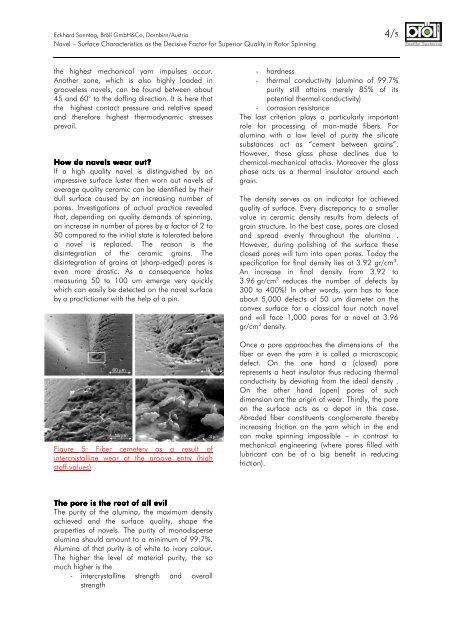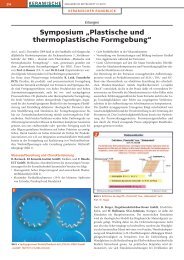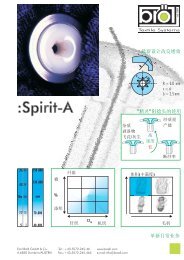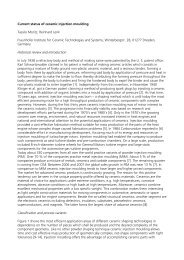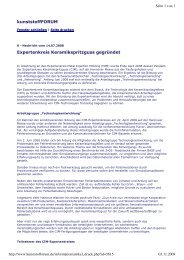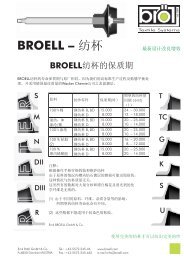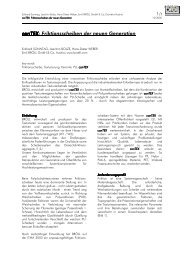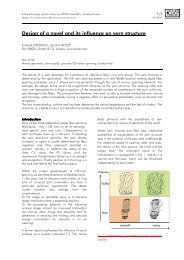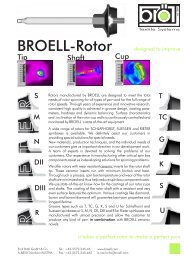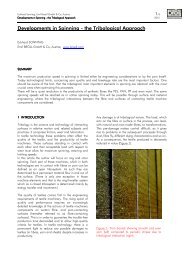Ad1-Internetartikel english
Ad1-Internetartikel english
Ad1-Internetartikel english
You also want an ePaper? Increase the reach of your titles
YUMPU automatically turns print PDFs into web optimized ePapers that Google loves.
Eckhard Sonntag, Bröll GmbH&Co, Dornbirn/Austria 4/5<br />
Navel – Surface Characteristics as the Decisive Factor for Superior Quality in Rotor Spinning<br />
the highest mechanical yarn impulses occur.<br />
Another zone, which is also highly loaded in<br />
grooveless navels, can be found between about<br />
45 and 60° to the doffing direction. It is here that<br />
the highest contact pressure and relative speed<br />
and therefore highest thermodynamic stresses<br />
prevail.<br />
How How do do navels navels wear wear out?<br />
out?<br />
If a high quality navel is distinguished by an<br />
impressive surface luster then worn out navels of<br />
average quality ceramic can be identified by their<br />
dull surface caused by an increasing number of<br />
pores. Investigations of actual practice revealed<br />
that, depending on quality demands of spinning,<br />
an increase in number of pores by a factor of 2 to<br />
50 compared to the initial state is tolerated before<br />
a navel is replaced. The reason is the<br />
disintegration of the ceramic grains. The<br />
disintegration of grains at (sharp-edged) pores is<br />
even more drastic. As a consequence holes<br />
measuring 50 to 100 um emerge very quickly<br />
which can easily be detected on the navel surface<br />
by a practictioner with the help of a pin.<br />
Figure 5: Fiber cemetery as a result of<br />
intercrystalline wear at the groove entry (high<br />
staff-values)<br />
The The pore pore is is the the root root of of all all all evil<br />
evil<br />
The purity of the alumina, the maximum density<br />
achieved and the surface quality, shape the<br />
properties of navels. The purity of monodisperse<br />
alumina should amount to a minimum of 99.7%.<br />
Alumina of that purity is of white to ivory colour.<br />
The higher the level of material purity, the so<br />
much higher is the<br />
- intercrystalline strength and overall<br />
strength<br />
- hardness<br />
- thermal conductivity (alumina of 99.7%<br />
purity still attains merely 85% of its<br />
potential thermal conductivity)<br />
- corrosion resistance<br />
The last criterion plays a particularly important<br />
role for processing of man-made fibers. For<br />
alumina with a low level of purity the silicate<br />
substances act as “cement between grains”.<br />
However, these glass phase declines due to<br />
chemical-mechanical attacks. Moreover the glass<br />
phase acts as a thermal insulator around each<br />
grain.<br />
The density serves as an indicator for achieved<br />
quality of surface. Every discrepancy to a smaller<br />
value in ceramic density results from defects of<br />
grain structure. In the best case, pores are closed<br />
and spread evenly throughout the alumina .<br />
However, during polishing of the surface these<br />
closed pores will turn into open pores. Today the<br />
specification for final density lies at 3.92 gr/cm 3 .<br />
An increase in final density from 3.92 to<br />
3.96 gr/cm 3 reduces the number of defects by<br />
300 to 400%! In other words, yarn has to face<br />
about 5,000 defects of 50 um diameter on the<br />
convex surface for a classical four notch navel<br />
and will face 1,000 pores for a navel at 3.96<br />
gr/cm 3 density.<br />
Once a pore approaches the dimensions of the<br />
fiber or even the yarn it is called a microscopic<br />
defect. On the one hand a (closed) pore<br />
represents a heat insulator thus reducing thermal<br />
conductivity by deviating from the ideal density .<br />
On the other hand (open) pores of such<br />
dimension are the origin of wear. Thirdly, the pore<br />
on the surface acts as a depot in this case.<br />
Abraded fiber constituents conglomerate thereby<br />
increasing friction on the yarn which in the end<br />
can make spinning impossible – in contrast to<br />
mechanical engineering (where pores filled with<br />
lubricant can be of a big benefit in reducing<br />
friction).<br />
Emil Emil Bröll Bröll GmbH GmbH GmbH &<br />
&<br />
Co. Co. Holzstr.1 D-<br />
73650 Winterbach


